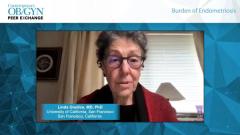
GnRH Antagonists for the Treatment of Patients With Endometriosis
Hugh Taylor, MD, along with a panel of experts, discuss the role of GnRH antagonists for the treatment of patients with endometriosis.
Episodes in this series

Hugh Taylor, MD: Linda, you’re involved with the development of some of the GNRH antagonists. Now that we have GNRH antagonists, is that your standard second line after oral contraceptive or progestin for women with endometriosis pain?
Linda Giudice, MD, PhD: Pretty much. It’s opened the door. As you know, the GNRH antagonists will have an increasingly important role in replacing the GNRH agonists. They don’t have the flare effect. They have short half-lives. They’re oral, with small molecules. It’s not injectable. If patients don’t like the adverse effects from them, they can stop and the effects of the drug are pretty quickly cleared from circulation. So yes, I use that as the next go-to.
Hugh Taylor, MD: That rapid clearance is also very nice for a patient with infertility or who’s considering a family in the near future. The lingering effects of the GNRH agonist can last for months, sometimes before fertility is restored, so it’s very useful in that patient population. Susie, when do you decide to transition somebody from oral contraceptive or progestin to GNRH antagonists?
Sawsan As-Sanie, MD: That’s a good question. It’s a hard question because there isn’t clear data-driven guidance. In general, the decision to transition from 1 hormonal suppression method to another is when the pain hasn’t improved or the patient has intolerable adverse effects on 1 option. You get more profound estradiol suppression with GNRH analogs, including the antagonists. If you’re concerned that you don’t have adequate suppression and combined oral contraceptive pill or progestin-only method, that would be an appropriate option to move on with patients. Even within the options of GNRH antagonists, there are a couple of options. There’s the low- and high-dose elagolix, and then there’s relugolix that has combination therapy. There are a variety of options that you can tailor to patients’ individual preferences. You might try 1 option, and if it’s not congruent with their goals or their expectations, then you might try another.
Hugh Taylor, MD: We’ll talk about the distinctions between the different GNRH antagonists in a bit. But I agree. Those are my main reasons. If somebody’s pain isn’t gone on an oral contraceptive, I tell them that they can expect to have their pain eliminated. That should at least be our treatment goal. Many women are suffering from some of those progesterone-related adverse effects, yet their pain is gone. They feel better, and they’re putting up with being very depressed or are having other progesterone-related adverse effects. Sometimes it’s a wonderful option. It’s important to listen to the patients and ask them about those progestin-related adverse effects. They may not tell you. They may come in and tell you, “My pain is gone. Thank you.” But when you ask them a little more depth, they’re having some significant adverse effects from progestins. One of these GNRH antagonists is the right thing to do. Jessica, is there anybody you’d start on a GNRH antagonist as first-line therapy?
Jessica Shim, MD: No, not typically in my age group. Unfortunately, I’m seeing patients at a time in their lives when there’s peak bone accrual. So we advocate for using something with hormonal therapy in the first line before Lupron [leuprolide] or GNRH agonists or antagonists.
Hugh Taylor, MD: Wouldanyone have a reason to start a GNRH antagonist as first-line therapy? Adverse effects from oral contraceptives are mine, or severe previous premenstrual alumina. If somebody has a significant mood disorder approaching their period, I may have a frank discussion with them that maybe progestins aren’t the way to go.
Robert Taylor, MD, PhD: Dyspareunia might be another indication. It’s a little hard to think of that as a first-line high-dose GNRH antagonist, but the evidence looks pretty good for that being a subset of patients who might benefit from that type of therapy.
Hugh Taylor, MD: Every once in a while, I find a patient with such severe debilitating pain that they want to go with something that’s likely to be effective as quickly as possible, and they’re willing to back off or taper down and transition to a contraceptive or progestin later. I have patients asking for aggressive therapy.
Robert Taylor, MD, PhD: The titrate ability of the oral GNRH antagonist is a nice aspect of those. I don’t know that that’s been as well developed practically, but theoretically, the ability to dial your estradiol levels up or down is an exciting opportunity to think about how to use those drugs.
Hugh Taylor, MD: Absolutely.
Linda Giudice, MD, PhD: It’s also important to set expectations with patients or the GNRH antagonists aren’t going to work immediately. It usually takes several weeks before symptoms are affected. Before dialing up, because usually we start at a lower dose, I usually recommend that patients wait at least 4 to 6 weeks to see how they’re doing and then have that discussion about dialing up. But I agree, Rob. It’s a great opportunity because 1 size does not fit all.
Hugh Taylor, MD:Exactly. I give them about 6 weeks, and I tell them that we should expect to see an appreciable improvement by then. Then let’s start to change therapy.
TRANSCRIPT EDITED FOR CLARITY
Newsletter
Get the latest clinical updates, case studies, and expert commentary in obstetric and gynecologic care. Sign up now to stay informed.

























